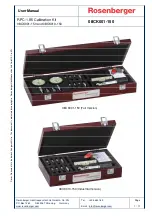
User Manual
RPC-1.85 Calibration Kit
08CK001-150 and 08CK010-150
08CK001-150
Rosenberger Hochfrequenztechnik GmbH & Co. KG
P.O.Box 1260 D-84526 Tittmoning Germany
www.rosenberger.com
Tel. : +49 8684 18-0
Email : [email protected]
Page
13 / 17
D
ie
s
e
s
D
o
k
u
m
e
n
t
is
t
u
rh
e
b
e
rr
e
c
h
tl
ic
h
g
e
s
c
h
ü
tz
t
●
T
h
is
d
o
c
u
m
e
n
t
is
p
ro
te
c
te
d
b
y
c
o
p
y
ri
g
h
t
●
R
o
s
e
n
b
e
rg
e
r
H
o
c
h
fr
e
q
u
e
n
z
te
c
h
n
ik
G
m
b
H
&
C
o
.
K
G
Inner conductor protrusion
This may result in buckling of the socket contacts or damage to the internal structure of a
device due to the axial forces generated.
NOTE:
At no time should the pin depth of the connector be protruding
.
Inner conductor recession
This will result in poor reflection and possibly unreliable contact.
6.2.2 Gauges
The Rosenberger gauges are of screw-on type in plug and jack version. They can be used to
gauge calibration standards as well as test ports, test port cables, adapters and DUTs.
Naming convention:
A “gauge plug” (male) is used to measure a DUT with plug (male) connector. The gauge itself has
a jack (female) connector and needs a gauge block with plug (male) connector. For a “gauge jack”
(female) all gender are vice versa.
Checking devices for protrusion or excessive recession only a single measurement is sufficient.
More precise measurements or checking devices very close to critical limits should be done in
different orientations averaging up to 4 single measurements.
When a gauge block is used to initially adjust the gauge a torque spanner should be used to
tighten up the connection to the correct torque.
6.2.3 Connector gauge measurement resolution
Because of connector gauge measurement resolution uncertainties (one small division on the dial)
and variations in measurement technique from user to user connector dimensions may be difficult
to measure. Dirt and contamination can cause differences of 0.005 mm and, in addition, the way
that the gauge is used can result in larger variations. When using a gauge system for mechanical
compliance testing of connectors carry out the following procedure each time:
•
Carefully inspect the connector to be tested and clean it if necessary.
•
Clean and inspect the gauge and the gauge block.
•
Carefully zero the gauge with the gauge block in place.
•
Remove the gauge block.
•
Measure the connector using the gauge and note the reading.
•
Repeat the process at least once or more times as necessary.



































